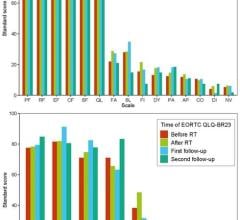August 4, 2014 — A two-step decision tree analysis, incorporating Donabedian’s model, is a feasible process to evaluate and distill the many available quality standards, guidelines, recommendations and indicators in order to update national and international quality standards for radiation therapy, according to a study published in the July/August 2014 issue of Practical Radiation Oncology (PRO), the official clinical practice journal of the American Society for Radiation Oncology (ASTRO).
Guidelines, recommendations and indicators may be utilized to develop new “best practice” standards through a formal consensus process and evaluation of the evidence base. The appropriate requirements and criteria for redeveloped standards, however, are not as well defined. This study, “Quality standards in radiation medicine,” was designed to identify and validate an appropriate approach to collate, catalogue and analyze existing quality standards. A two-step decision tree method allows for the organization of numerous different standards issued by a range of national and international organizations and identifies duplicate standards as well as gaps in the standards.
Quality-related documents were identified using Google Scholar and Discover and three selection criteria: 1) national or international; 2) contain statements or questions related to measuring quality in a broad sense in radiation medicine programs; and 3) written in English. Technical quality control standards were not included in this analysis. From this analysis, eight publicly available documents were used to identify 454 radiation therapy quality standards or groups of standards. Each of the five study authors completed two exercises to categorize the 454 identified standards to Donabedian’s structure, process or outcome, and also to the target of the standard: patients, staff, equipment or clinical process, or organization, for a total of 12 primary categories.
In exercise one, the 454 standards were categorized using a two-step process. The first step was to categorize the standards according to the Donabedian model, which provides a framework for examining health services and evaluating quality of care using three categories: structure, process and outcome. This categorization resulted in groups of approximately 150 standards each, making an in-depth analysis difficult.
To reduce the size of the groups, a second step was implemented to classify the 454 standards according to each standard’s target group (patients, staff, equipment or clinical process, or organization). This two-step process resulted in 12 primary classifications with an average size of 40 standards. The resulting smaller group size helped in identifying duplicate standards and key quality measures. The evaluators’ responses were examined for reliability using the Fleiss free marginal kappa. The agreement between the evaluators was fair (k from 0.21 to 0.40) or moderate (k from 0.41 to 0.60), meaning three or more reviewers assigned the same categories in both steps to 67 percent (304) of the 454 quality standards. In the Donabedian model step, three or more evaluators agreed on the classification for 93 percent (422) of the 454 standards.
A second exercise was conducted, to determine if greater consistency in categorizations could be achieved. The evaluators reassessed any standards that did not receive unanimous categorization (n=290) in the first exercise. The standards were again categorized using the Donabedian model. When the 290 reevaluations were combined with the 164 that received unanimous agreement in exercise one, the free marginal kappa improved to 0.71, which shows substantial agreement (k=0.61 to 0.80). In exercise two, 64 percent (290) were classified as structure, 26 percent (116) were classified for process, and 10 percent (45) were classified for outcome.
“This research provides a sound basis for refining the global approach to improving quality and safety in radiation therapy. Although there is no agreed upon ‘best practice’ to use as the basis for revising standards, the methodology used in our study may be helpful for organizations interested in a formal consensus process for revising documents,” said Peter Dunscombe, Ph.D., University of Calgary in Calgary, Alberta, and co-author of the study. “The analysis has already influenced refinement of the Canadian Partnership for Quality Radiotherapy’s Quality Assurance Guidance for Canadian Radiation Treatment Programs guideline document, supporting the CPQR’s work in further enhancing the high standards of Canadian radiation therapy treatment.”
For more information: www.practicalradonc.org


 March 28, 2024
March 28, 2024 








